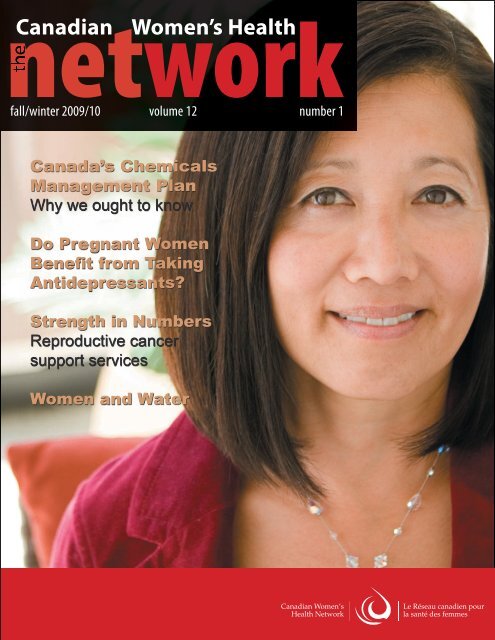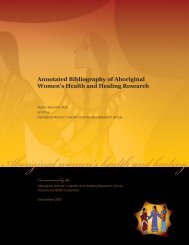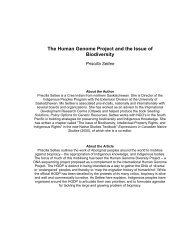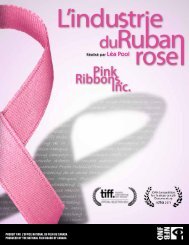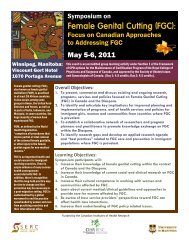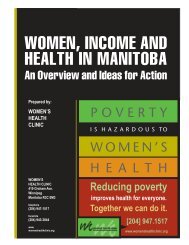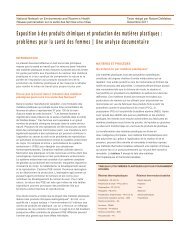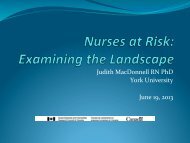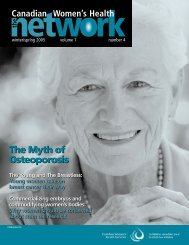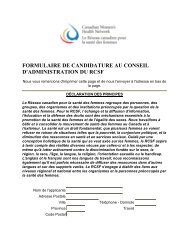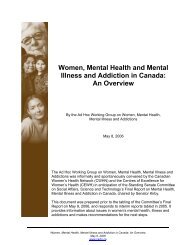Network 12-1.pdf - Canadian Women's Health Network
Network 12-1.pdf - Canadian Women's Health Network
Network 12-1.pdf - Canadian Women's Health Network
Create successful ePaper yourself
Turn your PDF publications into a flip-book with our unique Google optimized e-Paper software.
network<br />
<strong>Canadian</strong><br />
the<br />
Women’s <strong>Health</strong><br />
fall/winter 2009/10 volume <strong>12</strong> number 1<br />
Canada’s Chemicals<br />
Management Plan<br />
Why we ought to know<br />
Do Pregnant Women<br />
Benefit from Taking<br />
Antidepressants?<br />
Strength in Numbers<br />
Reproductive cancer<br />
support services<br />
Women and Water<br />
CANADIAN WOMEN’S HEALTH NETWORK FALL/.WINTER 2009/2010 1
e d i t o r ’ s n o t e<br />
I’m pleased to write to you for the first time as the new Editor of<br />
<strong>Network</strong> magazine and Director of Communications at the <strong>Canadian</strong><br />
Women‘s <strong>Health</strong> <strong>Network</strong>. It is exciting to take the helm of such a<br />
vibrant publication, and as we move forward I hope to continue to<br />
provide you with the best information and news on women’s health you<br />
have come to expect from <strong>Network</strong>.<br />
In this issue, profiles of work by the Centres of Excellence for<br />
Women’s <strong>Health</strong> gives readers a look at some of the latest projects on<br />
women’s health in Canada. In a piece by the CWHN’s new Director<br />
of Knowledge Exchange, Jane Shulman, we examine work from the<br />
Atlantic Centre of Excellence in Women’s <strong>Health</strong> on the support services<br />
available for women with reproductive cancers, and how they might<br />
expand by teaming up with existing breast cancer support networks.<br />
The experiences of young Aboriginal mothers are given a<br />
powerful voice in a report from the Prairie Women’s <strong>Health</strong> Centre of<br />
Excellence. In “Young Aboriginal Mothers in Winnipeg,” the firsthand<br />
accounts as well as the trends and statistics of motherhood in the city<br />
show the gaps in education and support.<br />
Based in Ontario, the National <strong>Network</strong> on the Environment and<br />
Women’s <strong>Health</strong> brings to light the way the chemicals in <strong>Canadian</strong>s’ lives<br />
are regulated with an article on Canada’a new Chemical Management<br />
Plan. Authors Dolon Chakavartty and Anne Rochon Ford break down<br />
<strong>Health</strong> Canada and Environment Canada’s plan to reexamine the safety of<br />
200 chemicals, and tell the public how they can learn more and voice their<br />
opinions. In “Women and Water,” NNEWH’s new online home for research<br />
on the relationship between women and water in Canada is examined.<br />
In research originally done for Women and <strong>Health</strong> Protection,<br />
Dr. Barbara Mintzes examines antidepressants, pregnancy, and what<br />
the evidence is for their use. Do they help, harm, or neither? In “Do<br />
The opinions expressed by contributors are their own and do not necessarily<br />
represent the views of the <strong>Canadian</strong> Women’s <strong>Health</strong> <strong>Network</strong>, its funders or<br />
its members. Arcles are intended to provide helpful informaon and are not<br />
meant to replace the advice of your personal health praconer.<br />
The <strong>Canadian</strong> Women’s <strong>Health</strong> <strong>Network</strong> gratefully acknowledges the funding<br />
support provided by the Women’s <strong>Health</strong> Contribuon Program of the Bureau<br />
of Women’s <strong>Health</strong> and Gender Analysis, <strong>Health</strong> Canada, as well as the<br />
support and donaons of the individuals and groups whose work strengthens<br />
the <strong>Network</strong>.<br />
network / le reséau<br />
volume <strong>12</strong> number 1 fall/winter 2009/10<br />
Editor: Signy Gerrard<br />
Translaon: Intersigne<br />
Subscripons: Léonie Lafontaine<br />
Advisory Commiee: Abby Lippman,<br />
Anne Rochon Ford, Martha Muzychka,<br />
Susan White and Madeline Boscoe<br />
<strong>Network</strong>/Le Réseau is published in<br />
English and French twice a year by the<br />
<strong>Canadian</strong> Women’s <strong>Health</strong> <strong>Network</strong><br />
(CWHN). Parts of <strong>Network</strong>/Le Réseau<br />
are also available on the CWHN website:<br />
www.cwhn.ca<br />
To subscribe to <strong>Network</strong> magazine, call<br />
1-888-818-9172 or email cwhn@cwhn.<br />
ca for details and payment opons.<br />
Individuals receive two issues of <strong>Network</strong><br />
for $15, four issues for only $25.<br />
Organizaons – two issues for $35. Back<br />
issues are also available at $5 each. We<br />
welcome your ideas, contribuons and<br />
leers. All requests for informaon and<br />
resources, as well as correspondence related<br />
to subscripons and undeliverable<br />
copies, should be sent to the address<br />
below.<br />
PUBLICATIONS MAIL AGREEMENT NO. 40036219<br />
RETURN UNDELIVERABLE CANADIAN ADDRESSES TO<br />
<strong>Network</strong>/Le Réseau<br />
<strong>Canadian</strong> Women’s <strong>Health</strong> <strong>Network</strong><br />
203-419 Graham Avenue<br />
Winnipeg MB CANADA R3C 0M3<br />
Tel: (204) 942-5500<br />
Fax: (204) 989-2355<br />
Toll-Free: 1-888-818-9172<br />
TTY (toll-free): 1-866-694-6367<br />
Email: cwhn@cwhn.ca<br />
Website: www.cwhn.ca<br />
CWHN Staff<br />
Execuve Director: Madeline Boscoe<br />
Assistant Execuve Director: Susan White<br />
Director of Communicaons:<br />
Signy Gerrard<br />
Director of Knowledge Exchange:<br />
Jane Shulman<br />
Technical Support: Polina Rozanov<br />
Administrave Services Coordinator:<br />
Léonie Lafontaine<br />
Resource Clerk: Tanya Smith<br />
Finance Officer: Janice Nagazine<br />
Bookkeeper: Rhonda Thompson<br />
2 FALL/.WINTER 2009/2010 NETWORK
pregnant women benefit from taking antidepressants?,” interesting questions are raised about what we know and<br />
what we assume about the benefits of one of Canada’s most frequently prescribed drugs.<br />
Finally, see an introduction to the CWHN’s latest online expansions - our new webinar series. Launched<br />
in the fall, these hour-long web broadcasts have already brought hundreds of participants new and important<br />
information on women’s health topics, from drug regulation in Canada to more from Dr. Mintzes on the risks and<br />
benefits of antidepressants in pregnancy. Look for upcoming webinars on the CWHN website and in the Brigit’s<br />
Notes newsletter as the year goes on!<br />
Sincerely,<br />
Signy Gerrard<br />
Director of Communications<br />
Support a national voice for women’s health!<br />
CWHN thanks all of our donors, who make such an important contribution to our work.<br />
If you would like to contribute, please go to our website www.cwhn.ca and click on “donate”<br />
or call CWHN at 1-888-818-9172 (toll free).<br />
WHAT’S INSIDE<br />
4 Aboriginal mothers in Winnipeg:<br />
Research looks at attitudes and<br />
understanding around sex and<br />
motherhood<br />
6 Canada’s Chemical<br />
Management Plan:<br />
Why we ought to know<br />
9 The comprehensive feminist<br />
approach to health<br />
11 Do pregnant women benefit<br />
from taking antidepressants?<br />
14 CWHN launches a new<br />
webinar series<br />
15 Strength in numbers:<br />
Project plans to unite support<br />
services for women with<br />
breast and reproductive cancers<br />
16 Women and water<br />
19 What we’re reading:<br />
Recommended resources<br />
from our library<br />
CANADIAN WOMEN’S HEALTH NETWORK FALL/.WINTER 2009/2010 3
A M <br />
Research looks at atudes and unders<br />
By Jane Shulman<br />
Aboriginal teenagers are four<br />
times more likely than non-<br />
Aboriginal teens to have<br />
babies. According to data cited in<br />
the report Young Aboriginal Mothers<br />
in Winnipeg, published in May<br />
2009 by the Prairie Women’s <strong>Health</strong><br />
Centre of Excellence (PWHCE),<br />
more than one in five First Nations<br />
babies were born to mothers aged<br />
15 to 19 years in 1999.<br />
By comparison, the <strong>Canadian</strong><br />
ratio was one in 20. Aside from<br />
the economic hardships that many<br />
young mothers face, there are increased<br />
health risks for babies born<br />
to teens. Researchers contend that<br />
there are socio-cultural issues at<br />
play that have not been thoroughly<br />
investigated.<br />
In order to uncover the issues<br />
that feed this trend, PWHCE<br />
researcher Lisa Murdock conducted<br />
interviews and group sessions with<br />
28 women living in Winnipeg,<br />
mostly between the ages of 18 and<br />
27 years old. She ventured to find<br />
out why girls from First Nations,<br />
Métis and Inuit populations<br />
are more likely<br />
than non-Aboriginals<br />
to become mothers at<br />
a young age, and support<br />
young mothers by<br />
asking women to tell<br />
her in their own words<br />
about their experiences.<br />
Themes included<br />
the women’s knowledge<br />
of sex before they<br />
became pregnant, their<br />
feelings about intimacy,<br />
where they learned<br />
about pregnancy and<br />
STIs (if they did), the support they<br />
received while pregnant and the<br />
challenges of young parenthood.<br />
You can’t<br />
just stop<br />
and tell<br />
kids they<br />
can’t get<br />
pregnant<br />
at a young<br />
age.<br />
There was significant focus on the<br />
kinds of programs that women<br />
would have accessed had they been<br />
available, and recommendations for<br />
future programming.<br />
Compelling in<br />
Murdock’s report<br />
is the first-person<br />
reporting from the<br />
women she interviewed,<br />
which illuminates<br />
the issues. The<br />
women in the project<br />
had lived experiences<br />
to share and insight<br />
that went beyond the<br />
telling of personal narratives.<br />
Murdock quotes an<br />
interviewee discussing<br />
teen pregnancy within<br />
the context of the oppression of<br />
Aboriginal peoples, and the breakdown<br />
of their family structure.<br />
4 FALL/.WINTER 2009/2010 NETWORK
W<br />
tanding around sex and motherhood<br />
“I think it goes back to a lot of<br />
different things. It goes back to dysfunctional<br />
homes, childhood sexual<br />
abuse, alcoholism, everything. It just<br />
comes down to it. When you get<br />
such abuse, a high percentage of the<br />
time you end up working the streets<br />
or you end up sleeping around, you<br />
end up having kids at young ages<br />
… You can’t just stop and tell kids<br />
they can’t get pregnant at a young<br />
age. It’s not good. You gotta work<br />
on the things that happened to them<br />
too … What’s making them become<br />
like that? It doesn’t mean all<br />
people are being sexually abused,<br />
but a high percentage of the people<br />
live in dysfunctional homes, and<br />
just want to feel loved and decide<br />
to have a baby at a young age. It<br />
becomes then, part of the system.”<br />
Murdock notes that women<br />
mentioned the differences between<br />
Aboriginal and non-Aboriginal<br />
beliefs around abortion and adoption<br />
as another reason for the high<br />
rates of teen pregnancy among<br />
Aboriginal women. Says another<br />
interviewee:<br />
“There’s a lot of girls out there<br />
who just want a baby. Even so<br />
young, they want to have a baby so<br />
they can have something to love, for<br />
someone to love them.”<br />
While the women interviewed<br />
said they were happy with the<br />
children they had, most said they<br />
thought young teens were not<br />
equipped to be having babies. They<br />
suggested prevention strategies<br />
including sex education starting in<br />
elementary school, presentations<br />
in high schools from young parents<br />
talking about their challenges, and<br />
better support programs for young<br />
parents. They stress that communication<br />
within families and between<br />
girls and people in their communi-<br />
ties is the key to prevention.<br />
“I’d say prevention first. Like,<br />
the whole talking to the guardian,<br />
like the parents and the guardian<br />
thing. Like teaching them how to<br />
talk to their kids, that’d be good.<br />
And a class how to talk to your<br />
parents might even help too because<br />
kids are really cocky these<br />
days. They’re trying to be independent,<br />
but that’s not the case. I think<br />
that would help. A class on how to<br />
connect with each other would be<br />
good.”<br />
The report, Young Aboriginal<br />
Mothers in Winnipeg, is available on<br />
the Prairie Women’s <strong>Health</strong> Centre<br />
of Excellence website at www.<br />
pwhce.ca/youngAborigMothers-<br />
Murdock.htm<br />
Jane Shulman is the Director of<br />
Knowledge Exchange at the <strong>Canadian</strong><br />
Women’s <strong>Health</strong> <strong>Network</strong>.<br />
CANADIAN WOMEN’S HEALTH NETWORK FALL/.WINTER 2009/2010 5
CANADA’S<br />
CHEMICALS<br />
MANAGEMENT<br />
PLAN<br />
Why<br />
we<br />
ought<br />
to<br />
know<br />
By Anne Rochon Ford and Dolon Charkavartty<br />
ONE WOULD EXPECT THAT THE THOUSANDS OF CHEMICALS IN DAILY USE – IN OUR<br />
HOMES, IN INDUSTRY, AND ELSEWHERE – HAVE BEEN THROUGH A FORMAL REVIEW<br />
PROCESS BY OUR GOVERNMENTS TO ENSURE THAT THEY ARE SAFE FOR HUMAN EX-<br />
POSURE. IN FACT, HOWEVER, MOST CHEMICALS IN CURRENT USE HAVEN’T BEEN FULLY AS-<br />
SESSED AND CAN REALLY ONLY BE CONSIDERED “SAFE” UNTIL IT’S PROVEN OTHERWISE.<br />
Fortunately, there is a possibility that this far-fromreassuring<br />
situation may change. In December 2006,<br />
the Government of Canada announced a new process<br />
for assessing and managing the potential health and<br />
environmental risks from over 23,000 chemicals that<br />
are widely used in Canada. Included in this “Chemicals<br />
Management Plan” (CMP) is a “Challenge” to<br />
industry: unless industry provides information that<br />
suggests otherwise, 200 of these chemicals will be<br />
considered toxic (as defined by the <strong>Canadian</strong> Environmental<br />
Protection Act or CEPA). In other words, the<br />
ground has shifted – in the case of some chemicals,<br />
at least – from “safe until proven otherwise” to “toxic<br />
until proven otherwise.” Given the increasing evidence<br />
linking exposure to even trace amounts of chemicals<br />
in our air, water, soil, food, and homes with chronic<br />
illnesses including cancer, this is a step in the right<br />
direction.<br />
Over a three-year period, <strong>Health</strong> Canada and<br />
Environment Canada have been releasing the names<br />
of fifteen of the 200 chemicals in question every three<br />
months. These chemicals will be re-evaluated based<br />
on four factors, namely persistence, bioaccumulation,<br />
inherent toxicity, and greatest potential for exposure.<br />
This re-evaluation is currently underway and<br />
individuals and groups in the general public – not<br />
just scientists and industry – are being encouraged to<br />
become knowledgeable about what is going on and<br />
to get involved. Funding was provided to the <strong>Canadian</strong><br />
Environmental <strong>Network</strong> / Réseau canadien<br />
de l’environnement (RCEN), in collaboration with<br />
the environmental NGO, Environmental Defence,<br />
6 FALL/.WINTER 2009/2010 NETWORK
to coordinate a process of civil<br />
society engagement. When the<br />
names of chemicals are released,<br />
the RCEN notifies a network of<br />
individuals and groups about them<br />
and explains what the government<br />
has concluded (based on existing<br />
research). The RCEN then<br />
provides its own “plain language”<br />
assessment of the literature and<br />
encourages citizen groups to learn<br />
more about these chemicals, many<br />
of which can be found in personal<br />
care products, household cleaners,<br />
cosmetics, and other products<br />
with which humans have regular<br />
contact.<br />
There will be opportunities<br />
for public input both when the<br />
quarterly releases of the names<br />
of chemicals occur (this process<br />
is now complete) and at the later<br />
stages when <strong>Health</strong> Canada and<br />
Environment Canada deliberate<br />
about how these chemicals will be<br />
“managed.”<br />
These deliberations will go on<br />
until some time in 2011.<br />
Why should women<br />
be concerned?<br />
There are both sex- (e.g.,<br />
biological) and gender-based<br />
(e.g.,social) reasons why women<br />
should be aware of these issues. In<br />
particular, women are known to<br />
have different experiences with<br />
and exposures to many of these<br />
The criteria by which chemicals are being evaluated<br />
1. Possibility for Persistence:<br />
The me it takes for a substance to break down in<br />
the environment<br />
2. Possibility for Bioaccumulaon:<br />
The tendency for a substance to accumulate in the<br />
ssues of living organisms and to travel along the<br />
food chain<br />
3. Inherent toxicity:<br />
Whether a chemical is inherently harmful to human health<br />
or to other living creatures (as disnct from<br />
the legal definion of “toxic” in CEPA)<br />
4. Represenng the Greatest Potenal for Exposure:<br />
Substances in vast amounts of use that can potenally affect<br />
large numbers of the populaon<br />
chemicals. To take the most obvious:<br />
only women get pregnant and<br />
give birth, and their exposures can<br />
affect the embryo and fetus. One<br />
particular concern is based in the<br />
substantial body of scientific literature<br />
demonstrating the unique<br />
vulnerability of the fetus to endocrine-disrupting<br />
chemicals found<br />
in daily environmental exposures<br />
to several chemical substances<br />
(e.g. pharmaceuticals in the water;<br />
Bisphenol A [BPA] found in plastic<br />
and food products; etc.).<br />
However, women’s special concerns<br />
go beyond their reproductive<br />
roles. Women and girls have other<br />
sex- and gender-based vulnerabilities<br />
to being exposed and to being<br />
harmed by the exposures that need<br />
to be considered in discussions<br />
about the control of chemicals.<br />
Sandra Steingraber’s work on the<br />
falling age of puberty provides<br />
compelling evidence to suggest<br />
that myriad factors, including<br />
exposures to endocrine-disrupting<br />
chemicals, play a role in accelerating<br />
puberty in girls.<br />
The social and caretaking roles<br />
carried out by many women,<br />
the nature of much of their paid<br />
employment in the service sector,<br />
and their greater use of personal<br />
care products (cosmetics, lotions,<br />
specialized cleansers, etc.) can<br />
all lead to daily exposure to certain<br />
chemicals, which put women<br />
at higher risk for health-related<br />
problems. Additionally, medical or<br />
health conditions that have been<br />
attributed to chemical exposures,<br />
CANADIAN WOMEN’S HEALTH NETWORK FALL/.WINTER 2009/2010 7
even though these associations<br />
are often deemed controversial<br />
in the medical community (e.g.<br />
fibromyalgia, Multiple Chemical<br />
Sensitivity Syndrome), tend to be<br />
diagnosed at much higher rates in<br />
women than men.<br />
Fitting sex and gender<br />
into the Chemicals<br />
Management Plan<br />
In response to this important<br />
initiative underway at <strong>Health</strong><br />
Canada and Environment Canada,<br />
and recognizing the importance of<br />
attention to sex- and gender-based<br />
aspects of it, the National <strong>Network</strong><br />
on Environments and Women’s<br />
<strong>Health</strong> (NNEWH) has undertaken<br />
a project to foster citizen engagement<br />
among women and women’s<br />
groups in the CMP. Janelle Witzel<br />
from Environmental Defence supports<br />
this engagement. “Women’s<br />
involvement and interest in the<br />
case of BPA was instrumental in<br />
prompting government action”,<br />
she said. “There is a large potential<br />
for women’s voice and participation<br />
in the CMP process ... that<br />
could lead to policy change.”<br />
The project, which the <strong>Canadian</strong><br />
Women’s <strong>Health</strong> <strong>Network</strong> is<br />
consulting on, will involve a public<br />
forum slated for February 2010,<br />
following a web-based survey seeking<br />
input from a broad range of<br />
women across Canada. For more<br />
information on these initiatives,<br />
check the websites of NNEWH<br />
(www.nnewh.org) and CWHN<br />
(www.cwhn.ca) for updates.<br />
Anne Rochon Ford is the Co-Director of<br />
the National <strong>Network</strong> on Environments<br />
and Women`s <strong>Health</strong> and Coordinator<br />
of the national working group Women<br />
and <strong>Health</strong> Protection.<br />
Dolon Chakravartty is a graduate<br />
student in Public <strong>Health</strong> Sciences and<br />
Collaborative Program in Environment<br />
& <strong>Health</strong> at the University of Toronto.<br />
She is the Graduate Fellow working<br />
with the National <strong>Network</strong> on<br />
Environments and Women’s <strong>Health</strong> from<br />
the Fall 2009 - Spring 2010.<br />
FURTHER READINGS:<br />
Altman, R.G., R. Morello-Frosch,<br />
J.G. Brody, R. Rudel, P. Brown,<br />
and M. Averick. (2008). Pollution<br />
comes home and gets personal:<br />
Women’s experience of household<br />
chemical exposure. Journal of<br />
<strong>Health</strong> and Social Behavior, 49(4):<br />
417-435. Available on line through<br />
www.ncbi.nlm.nih.gov/pmc/articles/<br />
Steingraber, Sandra. (2007, August).<br />
The falling age of puberty in girls:<br />
What we know, what we need to<br />
know. San Francisco, CA: Breast<br />
Cancer Fund. Available on line at<br />
www.breastcancerfund.org. Steingraber<br />
is careful to point out that a<br />
myriad of factors seem to be contributing<br />
to this trend, environmental<br />
exposures being one significant<br />
one.<br />
O’Grady, Kathleen. (2008/2009,<br />
Fall-Winter). Early puberty for<br />
girls. The new ‘normal’ and why we<br />
need to be concerned. <strong>Network</strong>,<br />
11(1): 11-13. Available on line at<br />
www.cwhn.ca/en/node/39365<br />
“Managing” the Chemicals<br />
“Management” can include a wide variety of policy measures; the choice<br />
is almost enrely at the discreon of the Government of Canada. While<br />
outright bans, and placing limits on producon, use, import and<br />
emissions of dangerous substances by regulaon are all possible, they<br />
are done relavely rarely.<br />
8 FALL/.WINTER 2009/2010 NETWORK
FURTHER RESOURCES:<br />
The <strong>Canadian</strong> Environmental Law<br />
Association (CELA) is a community-based<br />
environmental law clinic<br />
funded by Legal Aid Ontario, and<br />
has advocated for improvement<br />
and reform of the <strong>Canadian</strong> Environmental<br />
Protection Act for many<br />
years. For a collection of submissions,<br />
media releases and other<br />
commentary, see<br />
www.cela.ca/collections/pollution/chemicals-management-canada.<br />
The <strong>Canadian</strong> Environmental<br />
<strong>Network</strong>/ Réseau canadien de<br />
l’environnement (RCEN) has funding<br />
from Environment Canada to<br />
coordinate civil society participation<br />
in chemicals management in<br />
Canada:<br />
www.cen-rce.org/CMP/indexcmp.<br />
html<br />
Environmental Defence is an environmental<br />
group that is a member<br />
of the RCEN that “gathers, reviews,<br />
and analyses evidence related to the<br />
CMP on behalf of civil society” and<br />
makes this information available<br />
through the RCEN website. They<br />
have also mounted a campaign to<br />
encourage the federal government<br />
to designate the chemical 1,4-Dioxane<br />
as toxic. http://petition.<br />
environmentaldefence.ca/dioxane/<br />
Film: “Toxic Trespass”<br />
www.toxictrespass.com<br />
T<br />
<br />
<br />
<br />
<br />
Adapted from Changeons de Lunettes:<br />
Pour une approche globale et féministe de la santé,<br />
from the Réseau québécois<br />
d’action pour la santé des femmes<br />
THERE ARE MANY DIFFERENT WAYS OF CONCEP-<br />
TUALIZING HEALTH. ALTERNATIVE TYPES OF<br />
KNOWLEDGE HAVE ALWAYS COEXISTED WITH<br />
‘LEGITIMATE’ OR ACCEPTED KNOWLEDGE.<br />
Feminists have consistently played a key role in movements challenging<br />
the biomedical approach. The comprehensive feminist approach<br />
is based on eight pillars and is characterized by its critical<br />
stance toward medical and government institutions.<br />
With the new edition of the framework for women’s health,<br />
the Réseau québécois d’action pour la santé des femmes (RQASF<br />
– Quebec Women’s <strong>Health</strong> Action <strong>Network</strong>) offers a critical<br />
reading of the current situation and its causes, including the impact<br />
of globalization on our health and on our lives in general. It<br />
also proposes another vision and another approach to health.<br />
Film: “The Story of Stuff ”<br />
http://storyofstuff.com<br />
CANADIAN WOMEN’S HEALTH NETWORK FALL/.WINTER 2009/2010 9
A different perspective<br />
The following are the eight pillars<br />
of the comprehensive feminist<br />
approach to health:<br />
While biomedicine is a mechanistic<br />
concept of the body that<br />
divides the individual into a collection<br />
of component<br />
parts, the comprehensive<br />
approach is<br />
based on a conception<br />
of the human being<br />
as a whole (body and<br />
mind) interacting<br />
with their social and<br />
physical environment.<br />
Thus, this approach defines health<br />
in a holistic* way, as the result of<br />
social relationships.<br />
In contrast to a homogenizing<br />
vision of health, the comprehensive<br />
feminist approach advocates<br />
the recognition of the physiological<br />
and social differences between<br />
the sexes, while at the same time<br />
recognizing the differences between<br />
individuals, both women<br />
and men. This acknowledgement<br />
of a person’s many different characteristics<br />
— whether they are a<br />
man or a woman, rich or poor, gay<br />
or straight, living with a disability<br />
or not, etc. — is called intersectionality.<br />
According to the comprehensive<br />
feminist approach, in order to<br />
improve health, the social determinants<br />
of health must be taken into<br />
account; these are the factors that<br />
have the greatest impact on health,<br />
such as income, employment and<br />
housing.<br />
Contrary to an interventionist,<br />
cure-oriented medicine, the<br />
comprehensive feminist approach<br />
believes a population’s health cannot<br />
be improved without prevention and<br />
health promotion. <strong>Health</strong> is a matter<br />
of social justice. Consequently,<br />
It is essenal to exercise<br />
vigilance and crical thinking<br />
with respect to knowledge<br />
that is presented as universal<br />
governments must not abdicate their<br />
responsibility to enact legislation and<br />
regulations in all areas that affect the<br />
determinants of health.<br />
Self-care, taking charge of one’s<br />
own health, is another of the pillars<br />
of the comprehensive feminist<br />
approach. This is something that has<br />
traditionally been promoted by Quebec<br />
feminists, particularly in women’s<br />
health centres. Self-care involves<br />
a personal effort to understand the<br />
links between our health and our life<br />
circumstances. It aims to achieve a<br />
more egalitarian therapeutic relationship<br />
based on respect, communication,<br />
and the full participation of the<br />
person consulting the health care<br />
professional.<br />
Therapists and physicians are<br />
expected to show respect for people’s<br />
autonomy and their right to<br />
informed consent. Informed consent<br />
is a fundamental right, so therapists<br />
and physicians have a responsibility<br />
to provide all available information<br />
to those who consult them.<br />
Thus, certain types of<br />
biomedical knowledge historically<br />
based on the exclusion of<br />
women must be reexamined.<br />
It is essential to exercise vigilance<br />
and critical thinking with<br />
respect to knowledge that is<br />
presented as universal,<br />
often with the support<br />
of economic interests<br />
(the pharmaceutical<br />
industry, for example).<br />
Finally, the comprehensive<br />
feminist<br />
approach to health is<br />
distinguished from the<br />
dominant medical approach<br />
in its openness to alternative<br />
approaches. However, these<br />
approaches must also be underpinned<br />
by guidelines and regulations<br />
to safeguard the rights<br />
of the individual, both in their<br />
relationship with the health<br />
professional and in their choice<br />
of the approach to health care<br />
that best suits them.<br />
The full document Changeons de<br />
Lunettes (French only) is<br />
available to order at the website of<br />
the Réseau québécois d’action pour<br />
la santé des femmes (RQASF )<br />
www.rqsaf.com<br />
The RQASF is an provincial<br />
nonprofit mulitdiscplinary organziation.<br />
Their mission is to work<br />
in solidarity to better the physical<br />
and mental health of women of all<br />
walks of life. To learn more about<br />
their activities, consult their website<br />
10 FALL/.WINTER 2009/2010 NETWORK
Do<br />
pregnant women<br />
benefit<br />
from taking<br />
antidepres sants?<br />
By Jane Shulman<br />
Pregnant North American women are taking anti-depressants more than ever. The medical community has<br />
long advised women to avoid pharmaceuticals during pregnancy, but there is a growing trend to encourage<br />
women taking anti-depressants to keep taking them when they become pregnant, and to prescribe the drugs<br />
to pregnant women with depressive symptoms. The assumption being made with these prescriptions is that the potential<br />
risks to women and fetuses from taking anti-depressants outweigh the potential risks of letting depression go<br />
untreated. But is there really evidence of that these drugs benefit pregnant women, and does that benefit outweigh<br />
the potential risk?<br />
During a popular <strong>Canadian</strong> Women’s <strong>Health</strong> <strong>Network</strong> webinar last October, Dr. Barbara Mintzes discussed the<br />
history of prescription drugs during pregnancy and the current debate. Mintzes is an Assistant Professor at University<br />
of British Columbia’s Department of Pharmacology & Therapeutics, member of the UBC Centre for <strong>Health</strong><br />
CANADIAN WOMEN’S HEALTH NETWORK FALL/.WINTER 2009/2010 11
Services & Policy Research, and a<br />
Steering Committee member of<br />
Women and <strong>Health</strong> Protection.<br />
She and colleagues are aware of the<br />
conflicting information about the<br />
safety and benefits of taking selective<br />
serotonin reuptake inhibitor<br />
(SSRI/SNRI) class anti-depressants<br />
(such as Prozac, Paxil and Effexor)<br />
during pregnancy.<br />
What is known is that anti-depressants<br />
are being prescribed to<br />
pregnant women ‘off-label,’ meaning<br />
prescribed for a use for which<br />
they were not approved. Mintzes<br />
explains that “Anti-depressants are<br />
unapproved for use in pregnancy<br />
in Canada, or actually in any other<br />
country.” While it is illegal for drug<br />
companies to promote their products<br />
for ‘off-label’ use, doctors<br />
can prescribe any drug for any use<br />
once it is on the market.<br />
There is a generally recognized<br />
need for caution when using medications<br />
during pregnancy that has<br />
come out of two disasters – Thalidomide<br />
and Diethylsilbestrol<br />
(DES), drugs that had devastating<br />
effects on babies born to women<br />
who took them while pregnant.<br />
In the case of Thalidomide, some<br />
babies had severe birth defects.<br />
DES caused higher rates of cancer<br />
and reproductive problems in<br />
adult women who were exposed<br />
while their mothers were pregnant<br />
with them. DES sons also have<br />
higher rates of abnormalities of the<br />
reproductive organs. Additionally,<br />
women who took DES while pregnant<br />
have higher rates of breast<br />
cancer.<br />
These disasters, Mintzes notes,<br />
brought attention to the possibility<br />
of unpredictable and long-term<br />
harm from drug use in pregnancy.<br />
With that in mind, and with the<br />
conflicting advice women were<br />
receiving about using SSRIs while<br />
pregnant, Mintzes and colleagues<br />
decided to wade through the studies<br />
that had been done to see if there<br />
was in fact evidence of benefit to<br />
taking these drugs for women and<br />
their babies.<br />
Any time a medicine is used,<br />
there is a need to weigh the potential<br />
benefit against the potential<br />
harm. This is why medicines have<br />
to be tested systematically before<br />
they’re approved for use. With<br />
‘off-label’ use – as is the case with<br />
antidepressants in pregnancy - the<br />
company marketing the drug has<br />
not had to show scientific evidence<br />
to the government of a specific<br />
benefit for this use. That evidence<br />
may or may not exist. Since all<br />
medicines can cause harm as well<br />
as benefit, unless there is rigorous<br />
scientific evidence that benefit is<br />
likely to outweigh harm, a medicine<br />
should not be taken.<br />
Mintzes worked with Patricia<br />
Fortin, a research consultant at<br />
UBC’s drug assessment group Therapeutics<br />
Initiative, Jon Jureidini, an<br />
Associate Professor at the University<br />
of Adelaide’s Department of Psychiatry<br />
and UBC Pediatrics professor<br />
Tim Oberlander. Funded mainly by<br />
<strong>Health</strong> Canada’s Bureau of Women’s<br />
<strong>Health</strong> and Gender Analysis, they<br />
carried out a systematic search for<br />
all studies comparing women with<br />
depression who did or did not take<br />
antidepressants during pregnancy,<br />
and evaluated the study results.<br />
Their conclusion? Even after<br />
searching for all published and<br />
unpublished studies – worldwide<br />
– and despite the many claims made<br />
in favour of antidepressant use, they<br />
failed to find any scientific evidence<br />
that either pregnant women or their<br />
babies benefit from use of SSRI/<br />
SNRI antidepressants.<br />
Mintzes’ team found eight studies<br />
of women who were pregnant<br />
and diagnosed with depression. In<br />
all cases, the studies compared the<br />
outcomes for mothers and babies<br />
of those taking antidepressants and<br />
those who had no treatment of<br />
any kind. There were no studies,<br />
Mintzes notes, comparing pregnant<br />
women who took SSRI/SNRIs with<br />
those who were treated in other<br />
ways, such as cognitive-behavioural<br />
therapy or regular exercise.<br />
The size and quality of the eight<br />
studies varied, as did the degree<br />
of depression of the women who<br />
participated. All were observational,<br />
meaning that although there was a<br />
control group, women who chose to<br />
take antidepressants were compared<br />
with others who did not. Interpreting<br />
the results was complicated by<br />
differences between the women<br />
who took antidepressants and those<br />
who did not. For example, some<br />
had a longer history of depression or<br />
more severe depression.<br />
Five of the eight studies were<br />
also quite small, with weaker research<br />
methods, and in those cases,<br />
Mintzes notes it was hard to say why<br />
<strong>12</strong> FALL/.WINTER 2009/2010 NETWORK
there were so many poor birth outcomes.<br />
Was it the exposure to the<br />
drug, or was it because of differences<br />
between the women who were<br />
and were not taking antidepressants?<br />
Were issues like poverty, known to<br />
be a factor in depression and birth<br />
outcome, taken into account? The<br />
three larger – and more scientifically<br />
solid - studies they reviewed<br />
followed large populations of<br />
women, including one that included<br />
all women in British Columbia who<br />
gave birth between 1998 and 2001.<br />
However at the end of the review,<br />
none of the studies – whether<br />
large or small – showed any degree<br />
of benefit from antidepressant use.<br />
When there is no scientific evidence<br />
of benefit, says Mintzes, there is<br />
reason to be concerned when use of<br />
a treatment is widespread.<br />
In looking at studies in<br />
non-pregnant women as secondary<br />
evidence of whether or not there<br />
might be a benefit to pregnant<br />
women, Mintzes finds there isn’t<br />
evidence that SSRIs work better<br />
than non-drug treatment, like<br />
psychotherapy for most forms of<br />
depression, and she is concerned<br />
that the benefits of SSRIs in adults –<br />
pregnant or not – have been shown<br />
to be exaggerated. There is also the<br />
consideration that depression is<br />
often incorrectly diagnosed. A systematic<br />
review of studies found that<br />
family doctors incorrectly diagnose<br />
a person with depression 15 times<br />
for every 10 correct diagnoses.<br />
As for the impact on babies, the<br />
eight studies found that children<br />
born to women taking SSRIs had<br />
4.2% (1 in 24) greater incidence<br />
of respiratory distress than among<br />
women with depression without<br />
SSRI exposure, and a 0.6% higher<br />
rate of cardiac malformation (1<br />
in 159), again as compared with<br />
women not taking antidepressants.<br />
This is a signal that babies exposed<br />
to antidepressants seem to be doing<br />
worse in some ways than those not<br />
exposed. It adds to a larger body<br />
of literature on harmful effects of<br />
antidepressants in pregnancy.<br />
“The question is, why is this<br />
treatment being very heavily recommended<br />
for use in pregnancy given<br />
the lack of scientific evidence of<br />
benefit?” asks Mintzes. “There is no<br />
rationale for the recommended use<br />
of SSRIs in pregnancy.”<br />
Jane Shulman is the Director of<br />
Knowledge Exchange at the <strong>Canadian</strong><br />
Women’s <strong>Health</strong> <strong>Network</strong>.<br />
Watch the webinar at www.cwhn.ca<br />
CWHN is developing an in-depth information sheet about SSRIs and pregnancy available for download soon on our website.<br />
Some SSRI stats:<br />
• Andepressants are among the most frequently prescribed class of<br />
drugs for women of childbearing age in Canada.<br />
• In 2003 – 2004, 11-14% of women in Brish Columbia between the ages<br />
of 25 and 39 received at least one prescripon for an andepressant.<br />
• In 2008, 80% of women in Canada who spoke about depression to<br />
their doctors were given a prescripon, usually for an SSRI.<br />
• In 1998, just over of 2% of pregnant women in BC used an andepressant.<br />
By 2001, the rate of use had grown to 5%.<br />
CANADIAN WOMEN’S HEALTH NETWORK FALL/.WINTER 2009/2010 13
CWHN Launches Webinar Series<br />
Last fall, the <strong>Canadian</strong> Women’s <strong>Health</strong> <strong>Network</strong> (CWHN) launched its new series of webinars.<br />
The interacve lecture format allows presenters to speak to and take quesons from a na-<br />
onwide audience online, and allows audience members to interact and discuss presentaon<br />
material with each other. Sessions are also recorded and available on CWHN’s website for later<br />
viewing by those who couldn’t aend the webinar.<br />
SSRIs in Pregnancy: Is there evidence of benefit?<br />
Recorded October 29th, 2009<br />
An over-capacity registraon of more than one hundred people filled the inaugural webinar<br />
featuring Dr. Barbara Mintzes, who discussed the findings of her new systemac review on the<br />
benefits and risks of an-depressant use in pregnancy. Aendees, ranging from midwives to<br />
university classes and community/social services providers, finished the session with an enthusiasc<br />
queson period. For more informaon, see the arcle on Mintzes’ research, “Do Pregnant<br />
Women Benefit from Taking Andepressants?” in this issue.<br />
The Push to Prescribe<br />
Recorded November 4, 2009<br />
In the second of the webinar series, parcipants from government, the medical professions,<br />
professors, and students tuned in to hear from three authors of A Push to Prescribe, the new<br />
book on women and <strong>Canadian</strong> drug policy. The product of 10 years of research and policy-related<br />
work by Women and <strong>Health</strong> Protecon, as moderator and editor Anne Rochon-Ford put<br />
it, the book examines prescripon drug policy in Canada and the impact on women’s health,<br />
from clinical trials to markeng. Chapter authors Colleen Fuller and Abby Lippman spoke on<br />
“Reporng Adverse Drug Reacons – What happens in the real world” and “Inclusion of women<br />
in Clinical Trials – Are we asking the right quesons?” respecvely, and engaged in an acve<br />
discussion with parcipants.<br />
Both SSRIs in Pregnancy: Is there evidence of benefit? and The Push to Prescribe, including the<br />
aer-presentaon discussion period, are available for online viewing at www.cwhn.ca<br />
More are coming up soon!<br />
Check online or subscribe to Brigit’s Notes, CWHN’s monthly newsleer, for the announcement<br />
of upcoming webinars.<br />
14 FALL/.WINTER 2009/2010 NETWORK
STRENGTH<br />
in NUMBERS<br />
Project plans to unite support services for<br />
women with breast and reproductive cancers<br />
By Jane Shulman<br />
Cancer support networks in different parts of the country<br />
are looking at grouping women’s gynaecological<br />
cancers with breast cancer for the purpose of offering<br />
more support to women who have had a cervical,<br />
ovarian or uterine cancer diagnosis. Manitoba has been<br />
working on this for some time, explains Barbara Clow,<br />
director of the Atlantic Centre of Excellence for Women’s<br />
<strong>Health</strong>, and now New Brunswick and Newfoundland<br />
and Labrador are looking at their own models for<br />
delivering programming under the same umbrella.<br />
In a 2008 report for <strong>Canadian</strong> Partnership Against<br />
Cancer, called “Where Do We Go From Here? Support<br />
services for women with breast, cervical, ovarian and<br />
uterine cancer in Atlantic Canada,” Clow and co-authors<br />
looked at the idea of merging services to meet<br />
the needs of the underserved gynaecological cancer<br />
population.<br />
The idea is not without its detractors. Some have<br />
expressed concern that breast cancer groups might<br />
jeopardize their funding or lose their identity if they<br />
expand their mandate, or stretch their already overextended<br />
resources.<br />
But the focus on breast cancer over the past several<br />
years, with fundraisers and awareness campaigns popping<br />
up all over the country, means that the disease has<br />
a lot of attention, and Clow notes that it’s the kind of<br />
attention that gynaecological cancers desperately need.<br />
While she says that fewer women are diagnosed with<br />
cervical, ovarian and uterine cancers combined than<br />
breast cancer in Canada each year, with the exception<br />
of cervical cancer, their prognosis is not as good. And<br />
the psychosocial support specific to their kind of cancer<br />
just does not exist.<br />
Clow cites the work of volunteer-based Ovarian<br />
Cancer Canada as the only national gynaecologicallybased<br />
cancer group. There are no national groups for<br />
people with cervical or uterine cancer. The needs are<br />
different, but there’s overlap, which is why a program<br />
that pools resources for cancers that affect women is so<br />
appealing.<br />
The report recommendations included:<br />
Foster new research on the needs of women from<br />
vulnerable and disadvantaged communities who are<br />
faced with a diagnosis of cancer;<br />
Explore the possibility of adopting and adapting the<br />
processes and products developed by breast cancer support<br />
networks in Atlantic Canada to meet the needs of<br />
those with other women’s cancers;<br />
Promote the creation of publicly funded cancer patient<br />
navigator programs throughout Atlantic Canada.<br />
Clow says the next step is to look at how feasible<br />
this idea is, and where the desire lies. So far, nurses<br />
and service providers involved with the planning and<br />
delivering of programming are most passionate about it<br />
because they see the possibilities that lie in making the<br />
most of the services they can offer.<br />
Jane Shulman is a the Director of Knowledge Exchange at the<br />
<strong>Canadian</strong> Women’s <strong>Health</strong> <strong>Network</strong> and a former staff member<br />
of Breast Cancer Action Montreal.<br />
CANADIAN WOMEN’S HEALTH NETWORK FALL/.WINTER 2009/2010 15
Women<br />
and<br />
Water<br />
Wa<br />
By<br />
Signy Gerrard<br />
“Everyone thinks we have all this<br />
water,” says Jyoti Phartiyal of the<br />
National <strong>Network</strong> on Environments<br />
and Women’s <strong>Health</strong>, when<br />
speaking of <strong>Canadian</strong>s’ attitude<br />
towards one of our most essential<br />
resources - an attitude that reflects<br />
not only an assumption that supplies<br />
of water are endless and available,<br />
but safe for everyone.<br />
This is an assumption that<br />
new research from NNEWH examines<br />
in a website launched October<br />
6, 2009 – www.womenandwater.ca<br />
– that focuses on water,<br />
women, and their relationship in<br />
Canada today. The idea for the site<br />
was born while NNEWH led a<br />
program-wide research initiative<br />
on women and water in Canada,<br />
exploring <strong>Canadian</strong> water issues<br />
16 FALL/.WINTER 2009/2010 NETWORK
and the implications for women’s<br />
health.<br />
When asked about the gaps<br />
they found in research in Canada,<br />
Phartiyal immediately responds<br />
with “the biggest gap was the lack<br />
of gender analysis. It was just<br />
completely missing.” A “gendered”<br />
perspective was often limited to<br />
health as it related to fetuses or<br />
new babies. This gap was not just<br />
limited to <strong>Canadian</strong> research; few<br />
resources gave a gendered perspective<br />
on the issue of water in<br />
any developed countries. Most<br />
research discussed the relationship<br />
between women and water only<br />
in developing nations. While those<br />
studies could provide helpful information<br />
on some of the possible<br />
gender dimensions of water issues,<br />
the issues are likely to look very<br />
different in Canada.<br />
Believing that women have<br />
not only a historical and spiritual<br />
relationships with water, as well<br />
as potentially different effects on<br />
their health, the<br />
searchers, plans are to produce<br />
more documents in plain language<br />
geared towards policy makers and<br />
the general public in the future.<br />
The reports currently available<br />
on the website are organized<br />
into three themes of recent<br />
research: Aboriginal issues,<br />
Contaminants, and Privatization.<br />
In summer 2010 NNEWH will<br />
release the next volume in the<br />
Women & Water in Canada series<br />
on the gendered implications of<br />
chronic exposures to pharmaceuticals<br />
and disinfection by-products.<br />
Aboriginal water issues:<br />
According to womenandwater.ca,<br />
“as of December 31st<br />
2008, 106 First Nations communities<br />
in Canada were under drinking<br />
water advisories” – a dramatic<br />
example of the inequality of access<br />
to a vital resource. In some cases,<br />
these warnings have lasted for<br />
years. As stated in the report from<br />
the Chiefs of Ontario, Aboriginal<br />
As of December 31st 2008, 106<br />
First Naons communies in Canada<br />
were under drinking water<br />
advisories.<br />
Traditional Knowledge and Source<br />
Water Protection Final Report “in<br />
many First Nation cultures, the<br />
women of the community traditionally<br />
carry primary responsibil-<br />
researchers developing<br />
the website<br />
decided to further<br />
the discussion<br />
on women<br />
and <strong>Canadian</strong><br />
water policy by<br />
creating a central<br />
online location<br />
for information on the topic,<br />
featuring research from NNEWH,<br />
the Women’s <strong>Health</strong> Contribution<br />
Program, and key outside sources.<br />
As well as acting as an important<br />
resource for academics and reity<br />
for water.” Clearly, research<br />
needs to explore the social and<br />
cultural as well as physical health<br />
implications of poor water quality<br />
for women.<br />
The first report on this<br />
theme was created in partnership<br />
with the Prairie Women’s <strong>Health</strong><br />
Centre of Excellence. Released in<br />
April 2009, the Boil Water Advisory<br />
Mapping Project looks at the<br />
issue of water quality by examining<br />
the data available on boil water<br />
advisories in Canada – a recommendation<br />
typically made when<br />
the public has been alerted to take<br />
precautionary measures, (e.g. boil<br />
the water, at a rolling boil, for one<br />
full minute) to protect against a<br />
potential threat to health in public<br />
drinking water.. Without a standard<br />
measure of water quality in<br />
place, advisories provide a quick,<br />
although imperfect measure.<br />
As well as reviewing these<br />
advisories, the Boil Water Advisory<br />
Mapping Project highlights the<br />
important data<br />
gaps that need to<br />
be filled on topics<br />
like waterborne<br />
illnesses, the cost<br />
of water to consumers,<br />
and gender<br />
analysis in all<br />
of these issues. Future<br />
work in this<br />
area will focus on increasing the<br />
understanding of water’s meanings<br />
in Aboriginal communities, looking<br />
particularly at gender implications,<br />
as well as issues with regulations,<br />
funding, infrastructure, and more.<br />
CANADIAN WOMEN’S HEALTH NETWORK FALL/.WINTER 2009/2010 17
Contaminants in water:<br />
The outbreaks of disease in<br />
Walkerton and North Battleford,<br />
when E.Coli and cryptosporidium<br />
invaded the<br />
water supply,<br />
have thrown the<br />
issue of contaminants<br />
in water<br />
into the spotlight<br />
in recent years.<br />
While Microbiological<br />
contaminants<br />
such as the<br />
ones were found<br />
in those cases remain<br />
the biggest threat; however<br />
there is growing concern over<br />
the issue of chemical contamination<br />
of water. While this form of<br />
contamination may not result in<br />
immediate and dramatic health<br />
effects, the cumulative effects of<br />
long-term exposure are a serious<br />
concern.<br />
These cumulative exposures<br />
were researched and discussed in<br />
two soon-to-be released projects<br />
– in “The Gendered Effects of<br />
Chronic Low Dose Exposures<br />
to Chemicals in Drinking Water,”<br />
by looking at data across the<br />
country, researchers concluded<br />
that although Canada’s drinking<br />
water is “for the most part safe,”<br />
the quality was tied to where you<br />
live. In the second project, “Gendered<br />
Implications of Chronic<br />
Exposures to Pharmaceuticals and<br />
Disinfection By-Products in Typical<br />
Drinking Water” looks at what<br />
is released into our water from<br />
drugs and everyday personal care<br />
products, and by-products used in<br />
water treatment, how they interact,<br />
and what the implications<br />
are.<br />
As primary caretakers, most<br />
oen responsible for the health<br />
of their families, as well as their<br />
personal health, women are<br />
likely to be affected significantly<br />
Privatization of water:<br />
The question of whether water<br />
is a human right or a commodity,<br />
and the implications of those<br />
interpretations, is addressed in the<br />
research theme of Privatization.<br />
This research area addresses the<br />
rise of private sector involvement<br />
in the water supply networks, and<br />
the more business-oriented values<br />
that the sector brings with it. What<br />
do these shifts mean for women?<br />
As primary caretakers, most often<br />
responsible for the health of their<br />
families, as well as their personal<br />
health, women are likely to be affected<br />
significantly by these trends.<br />
The Significance of Privatization<br />
and Commercialization Trends<br />
for Women’s <strong>Health</strong>, a project<br />
in partnership with the Council<br />
of <strong>Canadian</strong>s, supported by the<br />
Prairie Women’s <strong>Health</strong> Centre of<br />
Excellence and Women and <strong>Health</strong><br />
Care Reform, looks at the push to<br />
privatize water in Canada. It ex-<br />
amines larger philosophical questions<br />
such as whether water should<br />
be privatized at all, and more<br />
practical issues such as water management<br />
models,<br />
privatization experiences<br />
and threats in<br />
Canada. The project<br />
also looks at what<br />
privatization may<br />
mean for women’s<br />
health, particularly<br />
Aboriginal women’s<br />
health.<br />
Signy Gerrard is the Director<br />
of Communications at the <strong>Canadian</strong><br />
Women’s <strong>Health</strong> <strong>Network</strong>.<br />
Visit the website at:<br />
www.womenandwater.ca<br />
Read the reports:<br />
Privazaon of water:<br />
www.womenandwater.ca/<br />
pdf/NNEWH%20water%20pr<br />
ivazaon.pdf<br />
Contaminants in water:<br />
www.womenandwater.ca/<br />
pdf/NNEWH%20water%20c<br />
ontaminants.pdf<br />
Aboriginal water issues:<br />
www.womenandwater.ca/<br />
pdf/NNEWH%20water%20c<br />
ontaminants.pdf<br />
18 FALL/.WINTER 2009/2010 NETWORK
WHAT WE’RE READING<br />
recommended resources from our library<br />
Rising to the Challenge:<br />
Sex and Gender-based Analysis for <strong>Health</strong><br />
Planning, Policy and Research in Canada<br />
By Barbara Clow, Ann Pederson, Margaret Haworth-Brockman,<br />
and Jennifer Bernier (2009)<br />
Rising to the Challenge is a book that describes the process of<br />
sex- and gender-based analysis and offers a collecon of case<br />
studies and commentaries that illustrate SGBA in acon. The<br />
book is of interest to people working on policy, planning and research<br />
and to people at various levels of government. It will help<br />
readers understand sex- and gender-based analysis and learn<br />
how to apply it in their work for and with women and men, girls<br />
and boys. Sex- and gender-based analysis reminds us to ask<br />
quesons about similaries and differences between and among<br />
women and men, such as:<br />
Do women and men have the same suscepbility to lung disease<br />
from smoking? Are women at the same risk as men of contracting<br />
HIV/AIDS through heterosexual intercourse? Are the symptoms<br />
of heart disease the same in women and men? Are x-rays<br />
equally useful for reflecng the level of disability and pain experienced<br />
by women and men living with osteoarthris? Do boys<br />
and girls have similar experiences of being overweight or obese?<br />
Do internaonal tobacco control policies work the same way for<br />
men and women?<br />
By introducing such quesons, sex- and gender-based analysis<br />
can help lead to posive changes in how programs are offered or<br />
how resources are allocated.<br />
To download an electronic copy or request a print copy,<br />
visit the website www.pwhce.ca, www.acewh.dal.ca,<br />
or www.bccewh.bc.ca<br />
Dissonant Disabilies:<br />
Women with Chronic Illnesses<br />
Explore Their Lives<br />
Diane Driedger & Michelle Owen<br />
(Women’s Press, April, 2008)<br />
This collecon of original arcles invites<br />
the reader to examine the key<br />
issues in the lives of women with<br />
chronic illnesses. The authors explore<br />
how society reacts to women<br />
with chronic illness and how women<br />
living with chronic illness cope<br />
with the uncertainty of their bodies<br />
in a society that desires certainty.<br />
Addionally, issues surrounding<br />
women with chronic illness in<br />
the workplace and the impact of<br />
chronic illness on women’s relaonships<br />
are sensively considered.<br />
Racialized Migrant Women<br />
in Canada: Essays on <strong>Health</strong>,<br />
Violence, and Equity<br />
Vijay Agnew (University of Toronto<br />
Press, 2009)<br />
Despite legislave guarantees of<br />
equality, immigrant women in<br />
Canada oen experience many<br />
forms of prejudice in their everyday<br />
lives. Racialized Migrant Women in<br />
Canada delves into the public and<br />
private spheres of several disnct<br />
communies in order to expose<br />
the underlying inequalies within<br />
Canada’s economic, social, legal,<br />
and polical systems that frequently<br />
result in the denial of basic rights<br />
to migrant women.<br />
CANADIAN WOMEN’S HEALTH NETWORK FALL/.WINTER 2009/2010 19
Diversity and Women’s<br />
<strong>Health</strong>: No Woman Le Behind<br />
Sue V. Rosser (John Hopkins<br />
University Press, June 2009)<br />
Once focusing solely on reproduc-<br />
on and reproducve maers, the<br />
study of women’s health has expanded<br />
to include cardiovascular<br />
disease, breast cancer, colorectal<br />
cancer, osteoporosis, and more.<br />
Yet the health care issues affecng<br />
diverse groups of women remain<br />
underfunded and understudied.<br />
Diversity and Women’s <strong>Health</strong> calls<br />
aenon to this glaring discrepancy<br />
and presents cung-edge<br />
reserach on women’s health from<br />
a femenist perspecve. The contributors<br />
argue that health issues<br />
specific to lesbians, elderly women,<br />
women of colour, immigrant<br />
women, and disabled women<br />
must become a central part of the<br />
broader conversaon on women’s<br />
health in the United States.<br />
Polygendered and Ponytailed: The Dilemma of Femininity<br />
and the Female Athlete<br />
Dayna B. Daniels (Women’s Press, June 2009)<br />
Since the 1970s North American women and girls have engaged in<br />
every sport that interests them and have become champions in their<br />
fields. One of the consequences of this success is ongoing cricism,<br />
not of how they perform, but of how they look. In Polygendered and<br />
Ponytailed, Dayna Daniels argues that the femininity-masculinity divide<br />
prevents women athletes from being taken seriously in their sports. As<br />
long as sports remains a male domain, girls and women who parcipate<br />
will be viewed as either masculine to begin with or masculine through<br />
their involvement. By embracing a polygendered way of being, which<br />
emphasizes the similaries between women and men, female athletes<br />
will be given the chance to achieve their full sporng potenal and be<br />
judged for their performance, rather than their appearance.<br />
Textual Mothers/Maternal Texts<br />
Elizabeth Podnieks and Andrea O’Reilly (Wilfred Laurier University<br />
Press, December 2009)<br />
Focuses on mothers as subjects and as writers who produce autobiography,<br />
ficon, and poetry about maternity. Internaonal contributors<br />
show how these authors use textual space to accept, negoate, resist,<br />
or challenge tradional concepons of mothering and maternal roles.<br />
CWHN Info Centre<br />
The <strong>Canadian</strong> Women’s <strong>Health</strong> <strong>Network</strong> invites you to search out women’s health database,<br />
a comprehensive bilingual collecon of women’s health publicaons and resources from<br />
across Canada and the world. With advanced search opons, the CWHN women’s health<br />
database gives you access to over 13,000 resources - publicaons, research, arcles, organizaons,<br />
reviews, and projects covering a wide range of informaon on women’s health and<br />
women’s lives.<br />
Search the CWHN Info Centre at our website: www.cwhn.ca<br />
20 FALL/.WINTER 2009/2010 NETWORK


